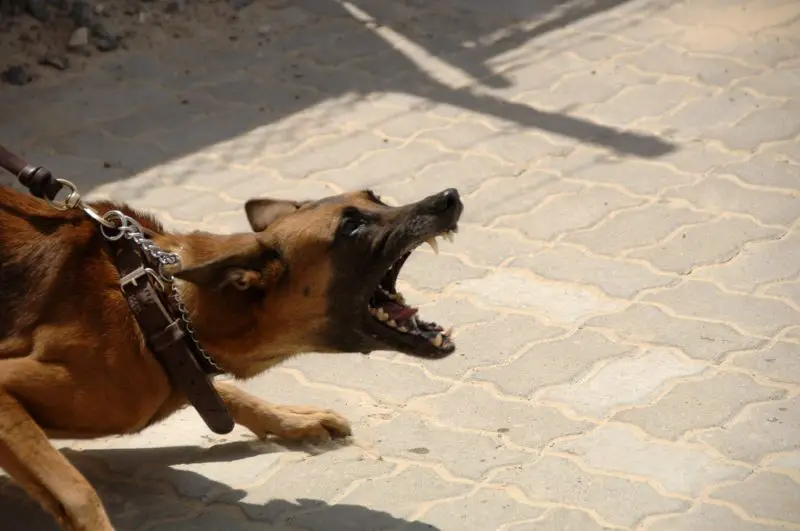How To Know If A Dog Has Rabies: 6 Symptoms To Watch Out For
Rabies is one of the most dreaded infections, both in dogs and humans. It’s highly contagious and incurable once the canine starts to show symptoms.

This is why pet owners should know what the virus looks like before it’s too late. In this post, I will discuss how to know if a dog has rabies, what you need to do, and the safety precautions you need to take.As much as rabies is terrifying, being knowledgeable can save the life of your dog and the people around. Read on to know more.

What is rabies?
Rabies is a contagious virus that’s highly preventable. It’s caused by an RNA virus belonging to the rhabdovirus family.

Once the rhabdovirus enters a dog’s body, it will attack the spinal cord and brain. This is why infected dogs will exhibit neurological symptoms discussed in the next section below.
In general, rabies infects dogs in two ways. First, it can enter through the peripheral nervous system and targets the brain directly. Next, it could replicate muscle tissue that prevents the immune system from detecting it. As the virus proliferates, it will start to attack the neuromuscular junctions of the brain.
Worldwide, about 60,000 people die due to rabies. This is roughly equivalent to someone dying of rabies every 9 minutes. Many of these cases are due to dog bites, but cats and other warm-blooded animals can also be carriers of the infection. please read here What Does it Mean When Your Dog Winks at You
In the United States, there are only a low number of rabies-infected canines due to vaccination programs. But since the infection can come from wild animals, unvaccinated canines are still at high risk.
Signs that a dog has rabies
Unfortunately, you can’t tell if an animal has rabies by simply looking at it. You have to know the early signs of an infection, including the following:

1. Vomiting
Vomiting is quite a general symptom for a slew of health problems. However, healthy dogs that suddenly vomit for no reason should be checked for rabies. This is much so if the canine is a stray and still due for a vaccination.
Moreover, vomiting is a sign that the body is trying to fight off something in its system. It can be a minor infection, poisoning, or the onset of rabies. When in doubt, it’s always best to get the canine checked, especially if it also exhibits the succeeding symptoms.
2. Sensitivity to various sensory stimuli
Another tell-tale sign of rabies in dogs is sensitivity to light, touch, and sound. Of the observed canines, photophobia or fear of light is the most prevalent symptom. You’ll notice the rabid dog squinting or trying to hide away from a light source. please read here 7 Ways On How To Make A Dog Stop Snoring
Meanwhile, touch and sound sensitivity can be pretty hard to assess since rabid dogs will act unpredictably. But if your once affectionate canine whines or becomes aggressive when you try to touch it, you should consider getting it checked.
Aside from that, rabid dogs will be afraid of water, also known as hydrophobia. The infected canine will stop drinking and eating at the same time. This is because the throat experiences massive spasms when trying to swallow.
As the rabies infection progresses, a rabid dog will suffer from seizures due to overstimulation. It only goes downhill from there. please read here Why Does My Dog Follow Me And Not My Husband
3. Sudden aggression
Sudden and intense aggression accompanied by hypersensitivity is often two of the hallmark signs of rabies in dogs. Your once calm canine will become snarly and ill-tempered when infected with rabies. But in rare cases, rabid dogs will become suddenly affectionate before the onset of aggression.
Aside from that, the infected canine will show odd behavior, including hallucinations. The dog will bark and snap at nothing or even chase non-existent objects.
Self-mutilation can also occur, especially if the rabid dog has an existing wound it can’t stop chewing or licking. please read here How To Stop A Dog From Chewing On Wood Trim
4. Incoordination and poor balance
As rabies infect the dog’s brain, the canine will become unsteady. You’ll notice the dog walking like a drunk person with poor coordination and balance. Some dogs will even suffer from partial paralysis.
5. Excessive drooling
Excessive drooling is the quintessential sign of rabies among canines. This will soon progress into foaming in the mouth and total refusal to eat or drink.
However, this shouldn’t be mistaken as typical drooling, especially if you have a dog breed known for salivating. please read here What Fred the Bull and Dog Breeds Have in Common for Dog Bite Cases in New York
If the excessive drooling is accompanied by jaw paralysis or lockjaw, you should carefully place the dog in the cage and bring it to the vet. These two symptoms point strongly toward rabies or tetanus infection.
6. Fever and lethargy
Lastly, a rabid dog will initially become lethargic and weak. It’s accompanied by fever as the body tries to fight off the infection. Over time, the symptoms I discussed above will start to develop.
Where do dogs get rabies?
Dogs usually contract rabies from an infected wild animal. It’s often transmitted through the saliva of an animal by biting.

Some of the most common carriers of the rabies virus are foxes, bats, raccoons, and skunks. If your dog hasn’t received its rabies vaccine yet, it’s best to keep it indoors away from these animals.Take note that rabies doesn’t show immediate symptoms. It may take up to 12 or more weeks of incubation before your canine starts showing symptoms. And once the symptoms begin to develop, it’s already too late for a treatment.
If your dog got bitten by a wild animal, it’s always best to bring it to the vet’s clinic. This is regardless if your canine has been vaccinated or not. The vet can still administer a booster shot aside from a tetanus shot to prevent tetanospasmin infection.
4 myths and misconceptions about dog rabies
Rabies is surrounded by many myths and misconceptions, which is also the reason why pet owners fail to protect their dogs. Here are some of the notorious myths that I debunked:
- Rabies is stronger on puppies. Nope! No matter what the age of the dog is, rabies remains equally infectious and deadly. So if a rabid puppy bites you, you should seek medical attention just the same.
- Rabies is only transmitted by biting. While biting is the most common means of rabies transmission, it’s not the only way for the virus to enter the body. Fresh saliva of an infected animal that landed on an open wound is enough to trigger an infection.
- Indoor dogs don’t need rabies vaccines. Any dog, whether an indoor or outdoor breed, should be given rabies shots. You’ll never know when a rabid animal will come in contact with your pet. Besides, it’s required by U.S. law.
- Rabies is incurable. This is partly true. Rabies can still be neutralized if you’ll bring your dog to the vet the moment it got bitten by another animal. The faster you act, the higher will be your dog’s chance of survival. You need to prevent the symptoms from developing because this is an incurable period.
How to prevent your dog from getting rabies
As I said, rabies is very easy to prevent. Here’s what you should do to keep your pet safe:
- Get it vaccinated! You can ask all veterinarians in the world, and they will agree on one thing: vaccination is the first line of defense against rabies. It’s a proactive approach that will save your dog from the gruesome symptoms of the infection.
- Avoid wild animals. It’s important to keep your dog leashed when bringing it outdoors. This way, you can stop the canine from chasing wild animals, especially breeds with high prey instincts. Take note that you should also keep your dog away from wild animal carcasses.
- Consider revaccination. Rabies is a core vaccine required under U.S. law. Depending on the assessment of your dog’s vet, revaccination can be done every one to three years.
- Regular vet visits. Taking your dog to the vet for routine checks will help detect the early signs of rabies. This will allow the veterinarian to administer treatments to prevent the virus from taking a deadly turn.
- Consider spaying or neutering your dog. By getting your pet fixed, the canines won’t seek each other for mating. This will also prevent a female dog from attracting a male canine that can be potentially rabid. please read here When Is It Too Late To Neuter A Dog? What You Need to Know
Has anyone survived rabies?
As of 2016, there are only 14 people recorded to have survived rabies infection after the onset of symptoms. This is a minuscule number compared to the almost 60,000 deaths a year due to the same infection.
This is why you should never take chances if you suspect that your dog has rabies. You should seek a doctor immediately if you got bitten to receive rabies and tetanus shots. The dog suspected of rabies should be taken to the vet and put down once it shows symptoms.
Can you get rabies from a non-rabid dog?
A dog that’s free of rabies will not give you rabies even if it bites. If your dog is fully vaccinated against rabies, there’s nothing you have to worry about.
Can a dog have rabies without symptoms?
Dogs can carry the rabies virus for days to weeks without experiencing symptoms, also known as the incubation period. During this period, the bite of a rabies-infected dog doesn’t carry infection yet as the rabies virus hasn’t reached the saliva yet.
But once the virus has reached the nervous system, your dog is guaranteed to show symptoms. This is a point of no return, and the best solution would be to put down the canine.
Can a vaccinated dog get rabies?
There’s no recorded case of a fully vaccinated canine contracting rabies. As long as your dog’s shots are updated regularly, it’s fully protected against rhabdovirus.
If your dog is showing symptoms similar to rabies despite being vaccinated, the vet is always the best person to consult. It’s likely a different condition that shares general symptoms with rabies infection.
What to do if a rabid dog bites you?
If a rabid-looking dog bites you, it’s important to wash the bite area immediately. Place the bite wounds under running water and rinse them with soap. This is to remove as much virus as possible before it travels inside your body.
After that, dab the wound dry and cover it with clean gauze. You should go to the doctor as soon as possible to receive anti-rabies and tetanus vaccines. This way, the virus will be neutralized even before it attacks your nervous system.
You’ll also be subjected to various tests, including blood, saliva, spinal fluid, and so on. This will determine whether the rabies virus has reached your nervous system or if your body successfully developed antibodies.
After the first rabies vaccine, you’ll be given four booster shots in the next 14 days to complete the treatment. Don’t worry because the rabies vaccine is proven safe for pregnant women with the close examination of a physician.
Wrapping up
Rabies is a highly feared infection because it can be transmitted to humans. With the knowledge on how to know if a dog has rabies, you can keep your pet and yourself safe from potential infection. You should also seek the vet’s advice if you’re worried about your dog.
